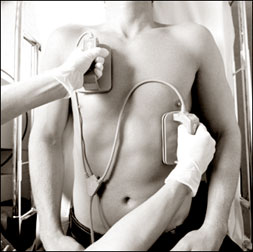|
Pre-diabetes:
A risk factor for heart disease and stroke
Jane hadn't been feeling well and frequent trips to the doctor over a
period of months didn't give her any answers. Jane's sister, Betty, was
worried that it might be diabetes.
 Betty had diabetes and Jane seemed to have some of the symptoms. She
also had a number of risk factors. Betty had diabetes and Jane seemed to have some of the symptoms. She
also had a number of risk factors.
Diabetes ran in the family. Jane was overweight and not very active
and she was getting older, if 60 is old. But the tests the doctor did
came back negative. Six months passed, the symptoms seemed to come and
go and yet there was no good explanation for why Jane didn't feel well.
One day when Jane was visiting, Betty encouraged Jane to test her
blood sugar. Jane agreed and used Betty's monitor. Much to Jane's
surprise the reading was high. Not really high, but higher than it
should be. At her next doctor's visit, Jane's provider retested her and
the test came back positive. Jane was told she had pre-diabetes.
She was also told that by changing her diet and exercising, she might
be able to delay the onset of type 2 diabetes. In most cases, people
will develop pre-diabetes before they develop type 2 diabetes.
Other names for pre-diabetes are impaired glucose tolerance and
impaired fasting glucose. These are the names of two tests commonly used
to determine if someone has pre-diabetes or diabetes.
When someone has pre-diabetes, their blood glucose levels are higher
than normal but not high enough to be diagnosed with diabetes. Most
people with pre-diabetes develop type 2 diabetes within 10 years.
However, the onset of diabetes can be prevented or delayed. The
Diabetes Prevention Program Study, completed in 2002, showed that the
onset of diabetes can be delayed by a slight weight loss, 7 percent to
10 percent of current body weight, and 30 minutes of moderate physical
activity at least five days a week.
These modest life-style changes were found to work better than
medication in delaying diabetes, although the medication did work.
If you have pre-diabetes, you can and should do something about it.
Pre-diabetes is not just an early warning sign for diabetes. Individuals
with pre-diabetes have a 1.5 times greater risk of cardiovascular
disease (heart disease and stroke) compared to people with normal
glucose levels. People who are at risk of diabetes are also at risk of
pre-diabetes.
You should be tested for pre-diabetes if:
* You are age 45 and older and overweight.
* You are younger than age 45, overweight and have even one of the
following risk factors:
* High blood pressure;
* Low HDL cholesterol and high triglycerides;
* Family history of diabetes;
* History of gestational diabetes (diabetes that occurs during
pregnancy);
* Gave birth to a baby weighing more than nine pounds; or
* Being a member of a racial or ethnic group, such as
African-American or Hispanic, that places you at greater risk.
If you are aged 45 and older, with a normal weight, ask your health
care provider if he or she recommends testing. People with pre-diabetes
may have the same symptoms of people with diabetes, such as unusual
thirst, a frequent need to go to the bathroom, blurred vision, and/or a
feeling of being tired most of the time but for no apparent reason.
But many people with pre-diabetes and type 2 diabetes don't have
symptoms, or the symptoms develop so gradually people don't recognize
them. That is why it is important to ask your provider about being
tested, particularly if you have a number of the risk factors mentioned
earlier. By the way, here's the rest of Jane's story. Jane continued
regular visits to her provider. She took better care of herself.
She lost weight and exercised regularly. She began to educate herself
about diabetes. She brought her blood sugar levels back to within a
normal range. She also understands that she will need to eat healthfully
and remain physically active to keep it that way.
(Source: Internet)
Simple rules stop flu in the workplace
Experts will tell you that the single best way to protect against the
flu is to get vaccinated each year.
 But let's face it; some of us ignore such health recommendations, no
matter how sound they might be. Consequently, we end up vulnerable to
the co-worker who shows up at work running a fever, coughing and
sneezing and putting everyone at risk of infection. But let's face it; some of us ignore such health recommendations, no
matter how sound they might be. Consequently, we end up vulnerable to
the co-worker who shows up at work running a fever, coughing and
sneezing and putting everyone at risk of infection.
The next best thing to do is keep your distance from the sick person
and follow some simple steps to lessen your chances of getting the flu,
said Eric Evans, state emergency management specialist for University of
Missouri Extension.
"Hand washing is the single most important thing you can do to
prevent the spread of a cold or flu virus," Evans said. Most health
experts say the rule of thumb is to wash hands with warm water and soap
for 15 seconds - or about the time it takes to sing "Happy Birthday to
You." Then, be sure to thoroughly dry them.
The flu "germ can get into any kind of wet membrane," Evans said.
"The germ can live for days and days, maybe weeks. It is not a cell;
it's a virus, which is basically a strain of DNA. That's what makes it
so dangerous. You can't kill the germ with antibiotics."
According to the Centers for Disease Control and Prevention, annual
influenza - better known as the flu - is a respiratory illness that can
be transmitted person to person through coughing or sneezing. The flu
also can be spread by coughing or sneezing on surfaces in areas of
common use.
In general, health experts say, most adults can infect others
beginning one day before symptoms develop and up to five days after
becoming sick.
Each year between 5 to 20 percent of the population gets the flu. Of
those infected, more than 200,000 are hospitalized with flu
complications and about 36,000 die, the CDC reported. People at a higher
risk for serious flu complications are those older than 65, young
children and people with chronic health conditions, Evans said.
So far this flu season, there have been 3,826 reported cases of flu
in Missouri, said Sue Denny, influenza coordinator for the Missouri
Department of Health and Senior Services. The flu season generally runs
from the first week in October to the middle of March.
"The last big year for influenza in Missouri was 2003, when there
were about 18,000 reported cases," Denny said. "Things are going as we
would expect so far this season." Evans said that besides hand washing,
people can protect themselves from infection at work by keeping a "safe
distance" - which is about three feet - from sick co-workers.
"It might appear strange or rude, but it can prevent infection," he
said. If you're sick, don't come to work. But if you do, cover your
mouth when you cough or sneeze, Evans said.
"Then, you should immediately wash your hands with soap and water,"
he said, adding that each employee should have a bottle of antimicrobial
hand cleanser on his or her desk.
"The flu costs billion of dollars in lost work time each year, and it
isn't that hard to prevent if you are vigilant," Evans said. Finally, he
said supervisors should make sure that common work areas are cleaned
often during the flu season to prevent that transfer of germs from
surfaces such as counters, conference tables and telephones.
"If you touch a contaminated surface and then touch your mouth, eyes
or nose, you have given an easy avenue for the flu virus to enter your
body," Evans said.
It's not too late to get a flu shot, which can cost as little as $10
at the county health department. "The flu is active through March, and
there is plenty of vaccine," Denny said. "The vaccine covers three
strains of flu and takes two to three weeks to take effect."
She also recommended that people older than 65 and those with chronic
diseases get a pneumonococcus vaccination because pneumonia is the most
serious complication of the flu.
Above all else, Denny implored people to wash their hands regularly.
"It's very, very important," she said.
(Source: Internet)
Effects of noise pollution
"Sound is of great value to man. It warns him of danger and
appropriately arouses and activates him. It allows him the immeasurable
advantage of speech and language. It can calm, excite and it can elicit
joy and sorrow" (Miller 1974).
Unwanted sound however constitutes noise. Noise can cause masking of
wanted sounds, interference with speech communication, pain and injury
and temporary or permanent loss of hearing. With a few exceptions (e.g.
thunder) loud noises are the product of modern man and evolution has had
insufficient time to develop adequate protection against extreme
exposures and noise pollution.
Noise pollution causes both physiological and pathological changes.
An acute response to acute noise pollution is an increase in blood
pressure.
More prolonged exposure to loud noise causes a transient dullness of
hearing and if exposure to noise is pronged over months or years, a
permanent threshold shift can result and the person experiences
difficulty in differentiating similar sounds particularly, those of
consonants. Noise induced hearing loss may also be accompanied by
tinnitus (ringing in the ears).
Excessive noise exposure causes damage to the outer hair cells of the
cochlea (spiral cavity of the inner ear) with breakage and disruption of
the pattern of cilia. The outer hair cells assist frequency selectivity
of the inner ear and amplication within the cochlea.
Noise pollution damages and physically disrupts this amplification
procedure. Non-auditory effects of noise pollution cause changes in
performance and health hazards.
Noise pollution can disturb the performance of mental tasks. There is
evidence to show that noise pollution from road traffic and loudspeakers
are associated with increase in cardiovascular morbidity (heart attacks
and angina).
The Health Ministry must arrange a programme of screening audiometry
where daily personal exposure to noise is of the order of 85 to 90 d B
(A). In some countries, noise induced hearing loss results in the
payment of compensation to those affected and redress may also be
available through the civil courts.
Dr. D. P. Atukorale.
Cholesterol link to early births
 Pregnant women who have very low levels of cholesterol may be at a
greater risk of giving birth prematurely, US research suggests. Pregnant women who have very low levels of cholesterol may be at a
greater risk of giving birth prematurely, US research suggests.
The National Human Genome Research Institute study confirmed previous
findings linking high cholesterol to a raised risk of premature birth.
But the researchers were surprised to find low cholesterol levels also
seemed to raise the risk. The study is published in the journal
Pediatrics.
It appears that too little cholesterol may be as bad as too much
cholesterol during pregnancy Dr Max Muenke National Human Genome
Research Institute Prematurity is associated to a raised risk of health
problems, including lung and heart conditions, blindness, deafness and
learning difficulties. The researchers examined more than 1,000 women
from South Carolina and their newborn babies.
They found 5% of women with moderate cholesterol levels gave birth
prematurely. In contrast, the prematurity rate among women with the
highest cholesterol levels - more than 261milligrams per decilitre
(mg/dl) - was about 12%.And among white women with the lowest
cholesterol levels - less than 159mg/dl - it was 21%.
However, no increase was observed among African American women in the
low-cholesterol category. |
